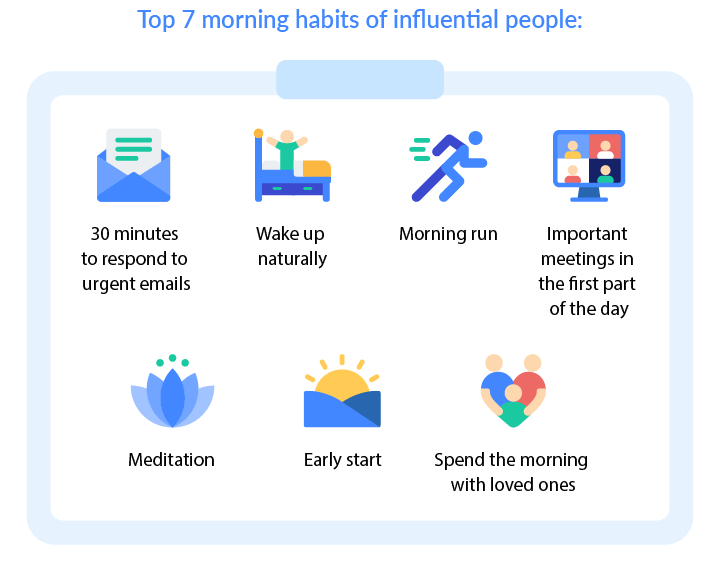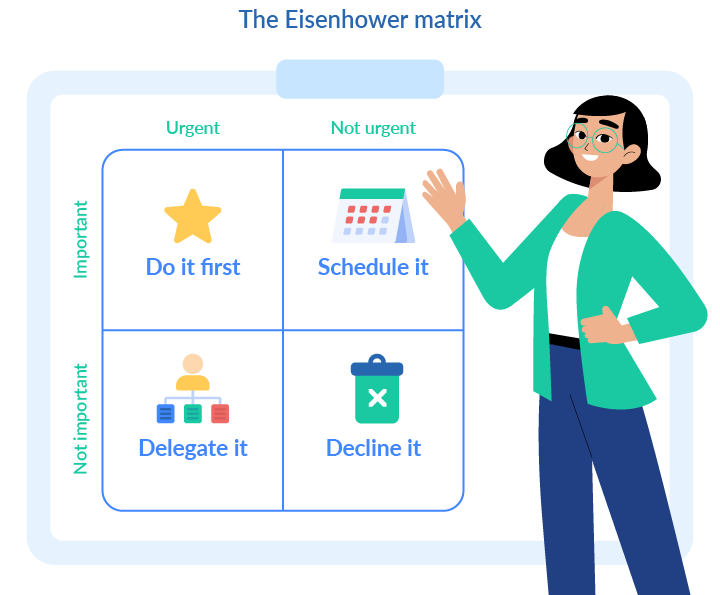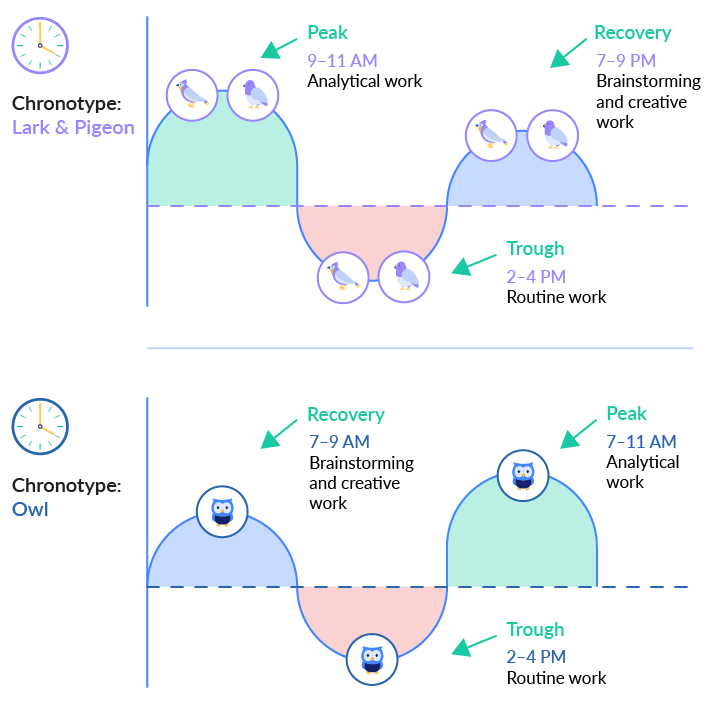Productivity is achieving desired results and experiences.
We all have 24 hours a day to get stuff done, whether we’re billionaires or self-employed entrepreneurs. Alas, only a few of us are actually in control of that time. We become stressed out too quickly in the face of our workloads, losing our concentration, motivation, and productivity. The best way to control the time you have for work is to plan your day wisely.
In this blog post, we reveal how to schedule your day and prioritize your work tasks to be as productive as possible throughout your workweek.
Why is productivity so important?
The first idea that springs to mind is probably increased revenue. But there’s more than that. The trick is that using the same amount of time and resources, you can streamline your processes and achieve your goals faster.
When we start working, we make the mistake of believing all tasks are urgent and high priority. Thus, our workday turns into juggling tasks that shouldn’t necessarily be done in one day. To be productive, you need to understand which 20% of tasks can bring you 80% of the results and plan your day accordingly. You might have heard this famous quote:

On average, we spend more than 60% of our time unproductively. This includes scrolling social media feeds, socializing, eating and drinking, and other forms of procrastination. That’s about three days of lost opportunities and lost income weekly. What’s more, you might lose up to two workweeks each month due to unproductive behaviors and habits, which amounts to six months per year. Add vacations and sick days and you’ll see that you may lose about seven months due to being unproductive.

Thus, it’s crucial to introduce a daily routine to organize your work time and put an end to wasted hours.
If you’re a business owner, you don’t need anyone to tell you that scheduling and running a business can be tough. Spreadsheets and calendars don’t provide a sufficient level of productivity, so it’s time to opt for more comprehensive solutions. ExpertBox provides specialists with all the digital tools they need to improve their day-to-day scheduling routines. Book a live demo and see for yourself
Top 7 morning routines of the most influential people
How to schedule your day for maximum productivity? To start with, take care of your morning routine. The way you start and end your day gears you up for success. Your daily rituals help you tune in, clear your head, and concentrate on what actually matters.
Morning routines vary from person to person. If you have a role model who’s famous and successful, you might get inspired by their morning routine and try it for yourself.
Below are some examples of morning rituals of some of the most successful people.
- Elon Musk. The famous engineer, technology designer, and booming entrepreneur is productive in literally every aspect of life. His success starts with proper time management. After six hours of sleep, Elon skips breakfast to kick-start his morning routine. Right from the start, he takes a shower, spends about 30 minutes responding to urgent emails, then drops his five kids at school and heads to the office.
- Mark Zuckerberg. The Facebook founder is not a morning person, so he doesn’t wake up early. He spends his morning similarly to Elon Musk — he also prefers to start his day with reading messages and emails and checking the news on Facebook for about an hour and a half. After that, Zuckerberg works out, showers, has breakfast, and heads to Facebook HQ.
- Oprah. The American talk show host and businesswoman devotes a big part of her life to meditation and spirituality. Usually, she starts before the sun comes up. After that, she goes for a walk accompanied by her five dogs, has a healthy breakfast, and gets down to business.
- Jeff Bezos. The Amazon CEO cherishes a proper eight hours of sleep and wakes up naturally without an alarm. He plans the most important and mentally consuming meetings early, at about 10 o’clock.
- Michelle Gass. The Kohl’s CEO and Starbucks ex-CEO sets her alarm at half-past four to go for a morning run. She has been sticking to this routine for more than 15 years and believes it has helped a lot in her success.
- Richard Branson. The Virgin Group magnate starts his morning with some cardio early, usually running or tennis, followed by breakfast with his wife and children. After that power boost, he gets to business and checks his emails.

As you can see, the most popular morning routines include waking up early, working out, mindfulness practices, and a healthy breakfast. Let’s move on to find out how to schedule your day to boost your productivity.
Daily scheduling methods to become more productive
The way you spend your morning might vary according to your preferences. However, there are some common approaches to effectively scheduling your day.
We’ve collected an ultimate checklist of how to segment your workday schedule:
- Time for deep work and analytical tasks — The most considerable part of your workday
- Time to speak — Meetings, daily stand-ups, negotiations, etc.
- Time for shallow work — An everyday routine that includes non-cognitive duties (checking and answering emails, backlog grooming)
- Time to unwind and reload — Coffee breaks, time for a power nap or walk
- Time for routines and daily rituals
Below are best practices to help you break your work schedule into a doable list of tasks to have a productive day.
Prepare the night before
David Allen, the father of the GTD method, says that his day starts the night before. The main evening routine for David is checking the calendar. It helps him see the whole landscape of the day ahead, prepare, and avoid surprises. Besides, it helps him calm down, rewind, and get a proper night’s sleep, as it’s essential to productivity.
How will preparing ahead help you schedule your day for maximum productivity? There’s a reason why this works. Let’s imagine that when you go to make your morning coffee, you have everything prepared — the coffee beans are in the machine and the sugar and cinnamon are next to it. This makes the process easy, and all you have to do is execute the task. You won’t resist doing your tasks, as you’ve already prepared for your success.
What can you do? Go through your calendar for tomorrow, prepare your clothes, put your sportswear for your morning exercise on the chair, check if you have everything for your other morning rituals, set the table, and plan priority tasks.
Review your tasks
Following the advice above, review the urgency of your tasks at the end of the day. It takes a pen, paper, and about 15 minutes to do but results in a launchpad for a highly productive day.
“Most of us spend too much time on what is urgent and not enough time on what is important.” — Stephen R. Covey, the author of The Seven Habits of Highly Effective People
Take a look at your usual schedule and filter tasks based on their urgency and importance. The Eisenhower matrix is a great tool to help you narrow down your to-do list and focus on what’s really important for you right now.
The matrix includes four categories:
- Important and urgent – tasks that need your priority focus
- Important but not urgent – tasks you can postpone for now
- Not important but urgent – tasks you may delegate to somebody else
- Not important and not urgent – tasks you can ignore or cancel

With a matrix like this, you’ll easily spot tasks that really need your attention so you can focus on them first.
Plan your energy throughout the day
When planning a productive day, you should consider your chronotype — the peaks and troughs in your productivity throughout the day. You’ve probably heard of larks, owls, and pigeons. Larks are morning birds and experience the peak of their productivity before noon. Owls, in contrast, perform better from afternoon to evening. Pigeons tend to follow the lark’s pattern, but with a little shift to the afternoon.
Acting on your biorhythm makes sense, as you can prioritize tasks and schedule them for your most productive part of the day. Thus, you can plan your day as follows:
- Schedule analytical tasks before and during your peak
- Switch to administrative tasks during your troughs
- Plan some creative and insightful activities during the recovery

By scheduling around your natural biorhythm, you’ll be most productive with urgent tasks that require you to be precise and won’t get distracted even during your troughs.
Automate your scheduling routine
To be more productive, you need to get rid of distractions and allocate your inner resources to the most important tasks. To get rid of distractions in the form of clients booking appointments, calling, and emailing back and forth, you can automate your scheduling with appointment scheduling software. It’s easy to integrate into your business and convenient for you and your clients. Besides, it helps you get rid of overbooking and last-minute cancellations, which enables you to concentrate and devote more time to your tasks.
Do you communicate with your clients online? Do you have to set dozens of appointments manually? Scheduling software can help you smoothly manage your appointments, simplify your administrative tasks, and boost your productivity. Read our guide on how to choose the right scheduling software for your business.
Eat the frog first
This is another excellent technique for how to schedule your day for maximum productivity. If there are several big and challenging tasks on your to-do list, go for the toughest one first. By the toughest one, we mean anything you’re surely going to procrastinate on: a monthly report, a pitch for your investors, etc. If you develop the habit of dealing with the big tasks right from the start of your day, you’re on your way to performing productively. Otherwise, it’s very likely that you’ll postpone these tasks, perform ineffectively, or miss the deadline. And there’s a good reason for such behavior.
Research by the University of British Columbia in Canada has proved that evolution played a trick on us, wiring our brains to be lazy. Our brains prefer to minimize effort, conserving energy for life-supporting activities like looking for food and shelter, finding a partner, and avoiding predators. So it’s natural that your first thought in the face of an important task is to avoid it and procrastinate. However, you shouldn’t fall for it but rather discipline yourself. The feeling of relief after you’ve accomplished the biggest task at the start of the day and the boost of energy are worth it.
Incorporate a power nap
After lunch, there’s little chance you’ll be productive or perform at your peak. Most likely, you’ll be sleepy, procrastinate, and be inattentive to details. If there’s a possibility to take a short power nap after you’ve had lunch, treat yourself to a 20-minute sleep to reboot, boost alertness and cognitive performance, and start over.

Pro tip: Have a cup of coffee right before you nap. It’s called a coffee nap. The caffeine kicks in about 20 to 30 minutes after consumption. Thus, after you’ve had some sleep, you’ll wake up refreshed, rested, and energized to have a productive afternoon.
90-minute focus sessions
Our bodies naturally operate according to biological cycles like circadian and ultradian rhythms. The latter was discovered by sleep researcher Nathan Kleitman, and it’s more commonly known as a basic rest-activity cycle (BRAC). BRAC is a popular time management tool based on periods of alertness (about 90 minutes) and rest (about 20 minutes) that follow each other.
In his research, professor K. Anders Ericsson analyzed the performance and daily routines of sportspeople, actors, and musicians. His findings show that top performers stick to working in 90-minute sessions with short breaks. Moreover, they rarely work for more than four and a half hours daily.
Why not adopt such a practice from the best performers to make the most of your day and be efficient? Try planning your activities according to a 90/20 pattern: do important tasks for about 90 minutes and then take a rest to recharge your batteries and start over. In this way, you’ll avoid exhaustion and fatigue and stay productive till the end of the day.
Pro tip: To make sure you spend your 90 minutes productively, create a distraction-free environment (turn off notifications, clean your desk, find a calm place), warm up, and set a time limit.
Set a cutoff time
Don’t work more than planned. If you do, your work will eventually consume all your life, leading to frustration and burnout. A lot of business owners don’t think they deserve time off; however, not taking time off will lead to tasks getting bigger and bigger, and you’ll never have time off.
When you have a cutoff time, you’ll be obliged to get things done by the deadline, thus performing more productively. People work much better under strict deadlines because there’s no other option than to just do it. So plan your workday, finish at the right time, and set your hobbies or meetings with friends right after your cutoff time so there’s no temptation to overwork.
Wrapping up
There are plenty of techniques to choose from to boost your productivity and spend your workday efficiently, and you can opt for the ones that fit your lifestyle and work pace. The key takeaways are to start your day with rituals that tune you in, schedule your priorities, use comfortable tools to automate your scheduling, and get enough rest to recharge your batteries for a new day.
Subscribe to our newsletter to get more tips on productivity and time management.
FAQ
-
You can adopt various approaches and techniques to schedule your day for maximum productivity. The most popular practices include:
- Preparing the night before
- Prioritizing tasks accordion to the Eisenhower matrix
- Scheduling your day following your natural peaks and troughs
- Using software to automate your scheduling
- Eating the frog first
- Having a power nap in the afternoon
- Working in 90-/20-minute sessions
- Setting a cutoff time at the end of your day



